International Business Machines Corp. (NYSE:IBM) has been placing a lot of its faith in the cloud in recent years. IBM cloud technologies span an incredible scope of solutions for data analytics, enterprise apps, human resource management, marketing and even gaming. By the end of 2017, about half of all large enterprises are expected to have hybrid cloud deployments operating. IBM holds a great many U.S. patents in the cloud computing sector, receiving 400 cloud computing patents thus far in 2015 and a total of 1,200 patents issued by the U.S. Patent and Trademark Office over the past 18 months. IBM’s own patent filings and its recent acquisition of cloud businesses like Compose, Inc., a developer of database as a service (DBaaS) cloud computing products, are helping the corporation to establish a truly dominant position in this field. More than one-third of all U.S. patents issued for cloud computing innovations belong to IBM, who has more than double the cloud computing patent portfolio of its nearest competitor Microsoft Corporation (NASDAQ:MSFT), according to statistics collected from Innography.
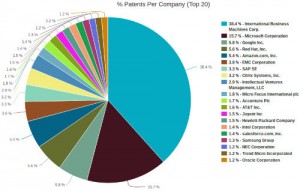 IBM’s portfolio of cloud computing services has been a topic that we’ve discussed before here on IPWatchdog. In the year leading up to the end of 2015’s first quarter, IBM’s cloud computing business earned $7.7 billion in revenue. By reaching people from all corners of the world, cloud services have an incredible ability to scale up and reach thousands upon thousands of users. One educational program implemented through the cloud, IBM’s Academic Initiative for Cloud, is predicted to reach up to 200,000 students attending 200 universities in 36 countries, training those students in cloud development.
IBM’s portfolio of cloud computing services has been a topic that we’ve discussed before here on IPWatchdog. In the year leading up to the end of 2015’s first quarter, IBM’s cloud computing business earned $7.7 billion in revenue. By reaching people from all corners of the world, cloud services have an incredible ability to scale up and reach thousands upon thousands of users. One educational program implemented through the cloud, IBM’s Academic Initiative for Cloud, is predicted to reach up to 200,000 students attending 200 universities in 36 countries, training those students in cloud development.
The dominance of IBM in cloud computing has enabled the corporation to secure some important business partnerships that look to build even more profits from this area of the company. The information technology company recently announced that it had struck an agreement with Apple Inc. (NASDAQ:AAPL) to develop a series of mobile enterprise solutions specifically for the iPhone and iPad platforms, including a number of native apps and unique cloud services designed for iOS. IBM will also be integrating its cloud services with the cloud content collaboration platform operated by Box Inc. (NYSE:BOX) to develop a wider audience for IBM’s social collaboration and Watson analytics tools.
[Companies-1]
IBM’s Cloud Computing Patents: From Computing Hardware Virtualization to Better Traffic Control
In a recent press release, IBM identified a series of recently issued patents from the U.S. Patent and Trademark Office that represent the wide range of the company’s cloud computing innovations. We’ll explore those five patents in more detail here.
For those readers who may need a primer in cloud computing, a very elemental aspect of these technologies can be explored within U.S. Patent No. 8984132, entitled System and Method for Supporting Secure Application Deployment in a Cloud. The method of securely deploying a software application in the Internet cloud protected here involves identifying the aspects of a software application that uses secure data, deploying secure data on secure servers that aren’t publicly accessible on the Internet and managing communications with public servers containing non-secure data with secure connections. This invention is part of the Infrastructure as a Service (IaaS) sector of cloud computing, which enables businesses who want to deploy an app without purchasing their own servers to do so by using computing resources made available by IBM. Specifically, this patent protects a system meant to encourage a more complete migration of enterprise software to the cloud by securing sensitive data that would otherwise be stored on computers at the 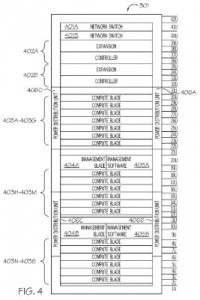 place of business. Further IaaS innovation pioneered by IBM is reflected within U.S. Patent No. 8984134, titled Unified Cloud Computing Infrastructure to Manage and Deploy Physical and Virtual Environments. This patent discloses a cloud computing system made up of cloud construction blocks of modular hardware pieces which are coupled to a management blade; the technology also incorporates the use of a processor to execute instructions for presenting a user interface for managing the modular pieces of hardware. The virtualization of the hardware components used for cloud computing environments creates a single management system for both hardware and software, obviating the need to purchase physical computing components while also streamlining cloud management interfaces.
place of business. Further IaaS innovation pioneered by IBM is reflected within U.S. Patent No. 8984134, titled Unified Cloud Computing Infrastructure to Manage and Deploy Physical and Virtual Environments. This patent discloses a cloud computing system made up of cloud construction blocks of modular hardware pieces which are coupled to a management blade; the technology also incorporates the use of a processor to execute instructions for presenting a user interface for managing the modular pieces of hardware. The virtualization of the hardware components used for cloud computing environments creates a single management system for both hardware and software, obviating the need to purchase physical computing components while also streamlining cloud management interfaces.
Technologies meant to ensure that cloud computing resources can be reliably accessed even when server problems are experienced are at the center of U.S. Patent No. 9015164, issued under the title High Availability for Cloud Servers. The method for providing a high availability system in a cloud computing environment protected here involves creating a virtual machine in response to a user request, creating a snapshot agent for the virtual machine which periodically takes snapshots of all files in a virtual machine. The snapshot manager is notified if the virtual machine experiences abnormal behavior and provides a recovery image for restoring the virtual machine. This invention provides a more cost-effective backup system than conventional replication or mirroring techniques. Greater availability of 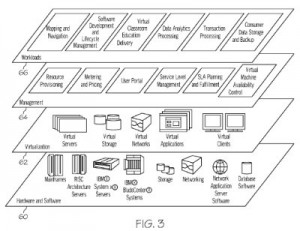 virtual machines for cloud customers is also discussed within U.S. Patent No. 8949415, which is titled Activity-Based Virtual Machine Availability in a Networked Computing Environment. The patent claims a computer-implemented method for activity-based virtual machine availability and control in a networked computing environment by monitoring network traffic through a virtual machine, performing packet inspection of the network traffic to identify a priority of a set of processes of the virtual machine, comparing network traffic volume to an availability threshold and performing a network traffic disablement action to conserve network bandwidth without disabling the virtual machine. This innovation saves a cloud customer money by reducing the amount of data transferred through a virtual machine without force-closing certain elements that will need to be manually restarted later.
virtual machines for cloud customers is also discussed within U.S. Patent No. 8949415, which is titled Activity-Based Virtual Machine Availability in a Networked Computing Environment. The patent claims a computer-implemented method for activity-based virtual machine availability and control in a networked computing environment by monitoring network traffic through a virtual machine, performing packet inspection of the network traffic to identify a priority of a set of processes of the virtual machine, comparing network traffic volume to an availability threshold and performing a network traffic disablement action to conserve network bandwidth without disabling the virtual machine. This innovation saves a cloud customer money by reducing the amount of data transferred through a virtual machine without force-closing certain elements that will need to be manually restarted later.
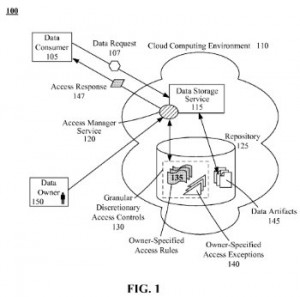 One of the strengths of cloud computing is the ability to conduct business across geographically disparate locations and greater control of the data transmitted to diverse regions is the focus of U.S. Patent No. 8990950, entitled Enabling Granular Discretionary Access Control for Data Stored in a Cloud Computing Environment. The patent discloses a system comprised of a cloud computing environment, a data storage cloud service, a plurality of data artifacts representing electronic data files and an access manager cloud service that manages storage of and access to the data artifacts. This cloud system is better capable than conventional cloud systems of providing access to needed training, business or other materials to members of an organization based upon owner-specified access rules.
One of the strengths of cloud computing is the ability to conduct business across geographically disparate locations and greater control of the data transmitted to diverse regions is the focus of U.S. Patent No. 8990950, entitled Enabling Granular Discretionary Access Control for Data Stored in a Cloud Computing Environment. The patent discloses a system comprised of a cloud computing environment, a data storage cloud service, a plurality of data artifacts representing electronic data files and an access manager cloud service that manages storage of and access to the data artifacts. This cloud system is better capable than conventional cloud systems of providing access to needed training, business or other materials to members of an organization based upon owner-specified access rules.
[Companies-2]
IBM Patent Applications for the Cloud: From Monitoring Eye Health to Plug-and-Play Cloud Provisioning
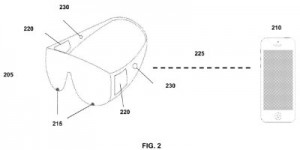 We were very intrigued to find a number of IBM’s recently filed patent applications which focus on some very specific implementations of IBM’s cloud, such as the medical technology described within U.S. Patent Application No. 20150161783, filed under the title Tracking Eye Recovery. This patent application would protect a method for tracking eye recovery by receiving eye image data from an eyewear, analyzing the data to determine an eye recovery status and providing a notification of the eye recovery status. The invention improves upon conventional eye shields for postoperative eye care by introducing a camera sensor which helps to monitor eye health during recovery from surgery or injury.
We were very intrigued to find a number of IBM’s recently filed patent applications which focus on some very specific implementations of IBM’s cloud, such as the medical technology described within U.S. Patent Application No. 20150161783, filed under the title Tracking Eye Recovery. This patent application would protect a method for tracking eye recovery by receiving eye image data from an eyewear, analyzing the data to determine an eye recovery status and providing a notification of the eye recovery status. The invention improves upon conventional eye shields for postoperative eye care by introducing a camera sensor which helps to monitor eye health during recovery from surgery or injury.
A couple of recently filed IBM patent applications detail cloud technologies designed to help business close out sales and move products more efficiently. More cost-effective techniques for order fulfillment are outlined within U.S. Patent Application No. 20150120599, entitled Partner Marketing and Order Fulfillment Based on Partner Merchant Shipping Efficiencies. The patent application discloses a computer-implemented method executed in a cloud environment for selecting a partner marketing communication by receiving data of a first order, determining a first fulfillment warehouse location for processing said order, identifying partner inventory at the first and multiple other warehouses and selecting at least one partner marketing communication based upon a comparison of the order to available inventory. This innovation is designed to cut down on shipping costs that might otherwise occur when orders from the same warehouse are charged shipping independently. A system utilizing the cloud to accurately determine when a specific customer will arrive at a brick-and-mortar establishment is discussed 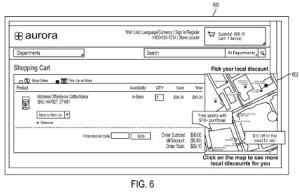 within U.S. Patent Application No. 20150120444, which is titled Partner Marketing Based on an Expected Customer Visit. The patent application would protect a computer-implemented method for again selecting a partner marketing communication, this time by receiving data of a potential visit of a customer to a location, making a determination that the customer or an agent of the customer may visit a location and selecting a partner marketing communication based upon the likelihood of the visit. This system is designed to help retailers share in the profits of sales generated when a coupon offered by one partner is used for a product created by another partner.
within U.S. Patent Application No. 20150120444, which is titled Partner Marketing Based on an Expected Customer Visit. The patent application would protect a computer-implemented method for again selecting a partner marketing communication, this time by receiving data of a potential visit of a customer to a location, making a determination that the customer or an agent of the customer may visit a location and selecting a partner marketing communication based upon the likelihood of the visit. This system is designed to help retailers share in the profits of sales generated when a coupon offered by one partner is used for a product created by another partner.
An IBM invention that makes it easier for cloud customers to ensure they have the cloud resources available to handle growing levels of customer requests is detailed within U.S. Patent Application No. 20150169291, which is titled Systems and Methods for Scaling a Cloud Infrastructure. It would protect a method of receiving resource-level metrics and/or application-level metrics, estimating parameters of an application based on those metrics and then automatically and dynamically determining directives for scaling application deployment based on the parameters. This technology is designed to remove some of the burden in determining how much and when to scale up cloud computing infrastructure resources. Automated systems for ensuring that a multitude of virtual machines can operate within a cloud environment without experiencing issues in operation are at the center of U.S. Patent Application No. 20150193244, entitled Autonomously Managed Virtual Machine Anti-Affinity Rules in Cloud Computing Devices. It protects a system comprised of one or more processors and a memory containing a program that, when executed, performs an operation of collecting performance metrics of a first virtual machine and defining at least one rule to restrict co-location of the first virtual machine with other virtual machines on a host machine in a cloud computing environment. The anti-affinity plan generated by this system is designed to prevent issues that can arise when many virtual machines target the same physical resource.
Cloud computing resources can be provisioned at lightning-quick speeds thanks to the technology disclosed within U.S. Patent Application No. 20150106521, titled Pluggable Cloud Enablement Boot Device and Method. This patent application would protect a computer-implemented method executed by a processor for providing a computing solution by providing a boot device that contains requirements for the computing solution including a software application and business logic, a system verification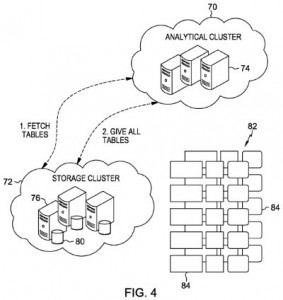 and integration mechanism and a building and integration mechanism. This invention results in a pluggable device that can quickly provision both hardware and software resources in such a way that it meets the requirements of customers of the organization. Finally, we were interested in an invention that looks to improve data retrieval from the cloud in response to ever growing stores of data online, reflected within U.S. Patent Application No. 20150186452, titled Adaptive Data Fetching from Network Storage. It would protect a method of adaptive data fetching in a networked computing environment which involves receiving a request from an analytical node for a set of data for performing a defined job, identifying a subset of the set of data from the networked storage and loading the subset of data to the analytical node in an order based on a sequence in which the subsets of data are projected to be accessed in the defined job. The adaptive data fetching techniques of this innovation are designed for high performance data analytics and reduce the chances of redundant data fetching.
and integration mechanism and a building and integration mechanism. This invention results in a pluggable device that can quickly provision both hardware and software resources in such a way that it meets the requirements of customers of the organization. Finally, we were interested in an invention that looks to improve data retrieval from the cloud in response to ever growing stores of data online, reflected within U.S. Patent Application No. 20150186452, titled Adaptive Data Fetching from Network Storage. It would protect a method of adaptive data fetching in a networked computing environment which involves receiving a request from an analytical node for a set of data for performing a defined job, identifying a subset of the set of data from the networked storage and loading the subset of data to the analytical node in an order based on a sequence in which the subsets of data are projected to be accessed in the defined job. The adaptive data fetching techniques of this innovation are designed for high performance data analytics and reduce the chances of redundant data fetching.

![[IPWatchdog Logo]](https://ipwatchdog.com/wp-content/themes/IPWatchdog%20-%202023/assets/images/temp/logo-small@2x.png)

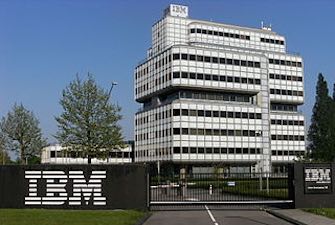
![[Advertisement]](https://ipwatchdog.com/wp-content/uploads/2024/04/Patent-Litigation-Masters-2024-sidebar-early-bird-ends-Apr-21-last-chance-700x500-1.jpg)

![[Advertisement]](https://ipwatchdog.com/wp-content/uploads/2021/12/WEBINAR-336-x-280-px.png)
![[Advertisement]](https://ipwatchdog.com/wp-content/uploads/2021/12/2021-Patent-Practice-on-Demand-recorded-Feb-2021-336-x-280.jpg)
![[Advertisement]](https://ipwatchdog.com/wp-content/uploads/2021/12/Ad-4-The-Invent-Patent-System™.png)







Join the Discussion
5 comments so far.
Anon
August 13, 2015 07:37 amBenny,
That comment by Mr. Olson was not the only such comment. I do believe a similar one was made by IBM.
After all, if you brush away the modern marketing, the current rage of cloud computing is nothing more than original IBM business model.
Benny
August 9, 2015 01:56 amAnon,
That quote is from Ken Olson, CEO of Digital equipment (an IBM rival) from 1977. DEC never did get into the personal computing market, and faded away in the early 90’s after a couple of takeovers.
Anon
August 8, 2015 10:17 amIBM’s comment about “who would ever want one of these things (a computer) in their home?” comes to mind…
Ron Hilton
August 8, 2015 09:55 amSome of the patents described in the article seem to be rather obvious combinations of known business methods with a cloud-based computer system. Others involve technology to improve the cloud computing system itself, which may be more novel/non-obvious. Of course many basic aspects of cloud computing were conceived and implemented years ago by IBM and others under the mainframe-based model of centralized computing.
Curious
August 7, 2015 11:38 amGene — off topic but the Economist printed an article that is just begging to be shredded apart. I was looking for the name of author but found none listed.